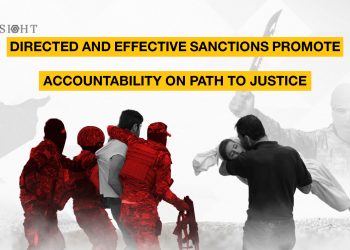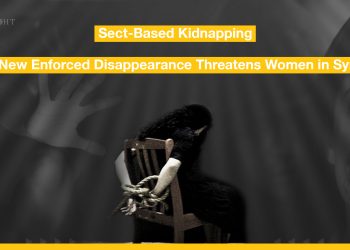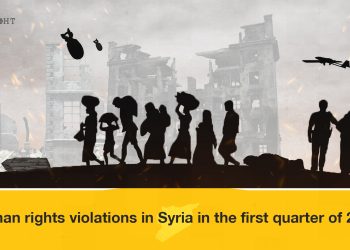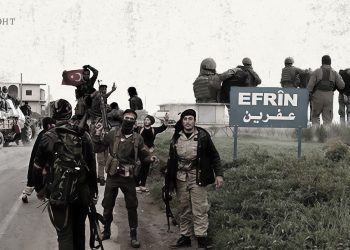Introduction
The issue of enforced disappearances in Syria is the most complicated one directly related to the political solution of the country, which might cover the whereabouts of hundreds of thousands of people who are still missing. The International Commission on Missing Persons estimate that 130 thousand persons[1] have disappeared in Syria since the beginning of the conflict in 2011.The real number could be higher in the absence of comprehensive statistics. All parties to the Syrian conflict and their foreign supporters caused the loss of these people.
In this report, we show a case from the most complicated part in the issue of enforced disappeared persons, the ones who were disappeared by ISIS which – that controlled large swaths of Syria and Iraq between 2013 to 2019. NGOs estimate the number of people forcibly disappeared by ISIS in Syria to be 20 thousand.[2] ISIS gunmen executed thousands of people, forcibly transferred thousands between Syria and Iraq, carried out dozens of massacres and left hundreds of mass graves, mostly not discovered yet.
Kobani is one of the cities that ISIS took control of in October 2014, causing the displacement of 400 thousand people, the killing and injury of more than 1500 others, and the loss of hundreds of people, some of whom were transferred to Iraq.
In this report, we shed light on the story of the enforced disappearance of five members of one family from Kobani countryside- by ISIS members nearly a decade ago. It is one example of dozens of similar cases of many persons missing from a single family, which in turn is a part of hundreds of other enforced disappearance cases in Kobani. This report will show the impact of enforced disappearance on the families of victims, especially elderly, women and children.
We also discuss the means to support the search for the truth and prevent the impunity of perpetrators despite the end of ISIS control on the ground.
For this report, – Insight – conducted four interviews with family members and four interviews with activists and human rights defenders. The report also incorporates material collected by the Insight team over the past year.
Escaping Poverty and Terrorism
The conflict in Syria following the 2011 protests- led to the deployment of different military factions and forces, followed by the emergence of ISIS in 2014 and its control of northern regions of the country.
Residents of many Syrian areas, including Kobani, remained in a besieged area with business interruption and income scarcity due to the loss of limited income from agriculture, urbanization, livestock husbandry and other work because of instability.
The emergence of ISIS in 2014 exacerbated the living distress and scarce employment opportunities for young people.
On August 15th, 2014, in the morning; six cousins went off from ‘Damargik’ village in southeast Kobani in north Syria, in an attempt to leave the country and head to the Kurdistan Region.
A bus owner told few local young men that he had paid a bribe to factions that control the way east of Kobani, and that he could deliver them to the Jazira region, from where there is a chance to leave the country and head to the Kurdistan Region.[3]
Those six young men joined the group that took the bus that day, which numbered around 30 people. [4]
Gunmen of the ‘Free Army’, factions and groups formed of armed dissidents and opponents, stopped the bus and took the passengers to Tal Abyad city where they were investigated and then released.
After leaving Tal Abyad, one of the passengers said that he did not get his phone back from the checkpoint’s members. Another one did not get his ID card back. They asked to return. The others suggested to continue and share to buy a phone, but the passenger said that he needed his identity card to exit the country. [5]
The bus returned back to Tal Abyad, at a time ISIS installed a checkpoint in Khurbat Hadla village. ISIS arrested the passengers and transferred them to Raqqa.
ISIS members closed the curtains, handcuffed and blindfolded the passengers and took the bus to the governor’s palace in Raqqa, which ISIS used it as its main headquarters.
Two days later, the bus driver was released. He told the families that their sons were arrested.
In less than a month, ISIS released some of the detainees, one from the same family; his two brothers and three cousins’ whereabouts remained unknown.
The mother of one of the missing said: “ My son left the house with his work clothes and carpentry hammer, the whole group headed to the Kurdistan Region in order to work.”[6]
The ages of the missing were between 16 and 30; two of them were married and had kids.
A committee consisting of the families of missing persons in Kobane documented the names of 562 persons from the city and its countryside who had been captured by ISIS, in individual and collective detention incidents followed by enforced disappearance.[7]
In a previous incident that took place on February 19th, 2014, ISIS militants detained approximately 160 people from a bus caravan. A few of them survived, primarily were women and men accompanied with women.
In a third incident that took place on May29, 2014, ISIS militants detained 153 students (between 14 and 16 years old) near Manbij on their way back from Aleppo city after completing their ninth grade exams.[8]
ISIS members ordered the girls to return back to Aleppo city, whereas
the boys faced detention and torture until their release on June28.
Searching for Truth
In the end of August-2014, Mislim Mahmoud, – the father of one of the missing persons and the uncle of the others- went to the governor’s palace in Raqqa. There, ISIS members told him that the young men are safe, “they are eating, drinking and sleeping, but it’s forbidden to meet them”.
For more than a month, he would go to the palace holding the paper of his family’s missing persons’ names on it.
“It was a Thursday, when a little boy came and said to me: they want you. I went and someone said to me: give me your sons’ names, I gave him the names. He missed about an hour and half an hour and came back to say: Old man, your sons are still being investigated.” [9]
After his repeated attempts to convince the ISIS members that his sons did not belong to any military or political party and that they only wanted to go to a place where they can get a job, they told him to come another day.
“Our appointment was on Tuesday, the ‘Da’ishi’[ISIS member] took the paper of the names, went for an hour and came back to say: your sons are not here with me.”
Because of frustration and the fear of the risks that might threaten his sons, the old man, Mislim, accused the ISIS gunmen of relying on lies or force confession under torture, so four members forcibly took him out of the building.
On September 7th, Mislim returned back to his village, not knowing what he would do next to find missing relatives.
On September 14, 2014, the family members were displaced to Turkey because of ISIS attacks on Kobani. They came back in June in 2015, after the SDF with the support of Global Coalition expelled ISIS members from the city and its villages.
After the liberation of Raqqa in 2017, Mislim headed there many times, but could not obtain any information.
Six months after the group’s arrest, Adle Hami – the mother of one of the missing persons- thought that the risk of her going to Raqqa might be less than that of men. She traveled to Raqqa, without informing any of her relatives.
“They asked me if my son was a fighter with the Kurdistan’s Workers Party [PKK], I told him if so, he would be with them. My son left the house with his work clothes and carpentry hammer.”[10]
In Turkey, Hami met someone who survived ISIS prisons and showed him her son’s photo. He told her that he had seen him as they met by coincidence during the lining and sitting in the prison, and said that he did not remember if his cousins were with him at that time or not.
“He told me that ISIS members transferred him with Raqqa’s prisoners to somewhere, there was a talk about exchange of prisoners with ISIS captives with SDF.”
Activists say that if the detainees were Kurdish, it was enough to be accused of aligning with the SDF against ISIS. The members also accused the detainees of apostasy after asking questions about worship and Sharia law. [11]
Impact on Families
The old parents of the four families, five children and three wives, one who had married only six months before the disappearance of her husband, were all affected.
Adle Hami said that her son was detained and then disappeared only two years after his marriage. His wife and two children are still waiting for him.
“The two kids would call me and their grandfather ‘mother and father’, but later and through the photos and conversations they recognized that their father is absent. They now ask: when will our father be out of the prison? When will he be back?”
She adds that her two other sons avoid hugging their children or flirting with their wives, taking in consideration the feelings of their brothers’ families’ members who all live together in the same house.
“I do not wish this fate on anyone, not even ISIS. I do not want any parents to suffer like us.”
The families’ homes were looted by ISIS members, when their residents were displaced to Turkey.
The family of Hajer Mohammad, who is the mother of one of the missing persons, has no breadwinner men, as she lost two of her sons in the bus incident and her husband died four years ago.
The older son was married to two women and had three children; the other was bachelor.
The families call on the United Nations, SDF, United States and Russia to help find out the fate of the missing.
One mother of the missing said: “I wonder if they are murdered or imprisoned? If we could just confirm that, everyone would know what to cry on, if only a person could tell us that he witnessed their death or survival, we would have calmed down. But it is as if they melted in that palace.”[12]
After a decade of the suffering because of the absence of their sons, the fathers and mothers cling to hope to the extent of recounting dreams or the conversations with clergy that endorse their children’s survival.
One father recalled that one of his acquaintances recounted a dream that his son was in a hole and his beard was long. The father interpreted that his son is alive but he struggles with difficult circumstances. A mother also quoted religious men she visited as confirmation that her son was alive, seeming optimistic.
A decade has passed since the incident and five years have passed since the end of ISIS control. Despite the complexities of the conflict on the ground like the Turkish invasion with its pro-factions of parts of north and east Syria, the families have not lost the hope of knowing the fate of their missing relativse.
Sources of Truth
In addition to the feelings of anguish experienced by the victims’ families, the enforced disappearance violates the rights of the victims themselves of safety, dignity and freedom from torture or cruel and degrading treatment or punishment.
According to article 17\1 of the Declaration on the Protection of all Persons from Enforced Disappearance, ‘acts constituting enforced disappearance shall be considered a continuing offence as long as the perpetrators continue to conceal the fate and the whereabouts of persons who have disappeared and these facts remain unclarified.’
Under article 9\1 of the same declaration ‘the right to a prompt and effective judicial remedy is required to prevent enforced disappearances under all circumstances’.
Although ten years have passed since this incident and much evidence has been lost, many entities could be sources of information about the fate of the missing by ISIS.
ISIS members, including those detained by Global Coalition and SDF or those in Turkey and Syria’s government’s areas; people who survived ISIS prisons and people who lived in the period of ISIS control and were in contact with its princes and leaders; could all be sources of information.
Until now, the family could not obtain any information from the SDF, and did not receive any calls from people who might know something about the fate of their sons.
On the other hand, ISIS is still active. Its cells launch attacks in the east areas particularly in the desert, which means the transfer of the central information from former princes to others.
According to – Insight- data, ISIS launched more than 132 attacks in the first quarter of 2024 and claimed responsibility for 94 of them.
The attacks were as follows: 71 against the SDF, 44 against the Syrian government, 8 against pro-Iranian factions and 9 against civilians.
ISIS gunmen killed 207 individuals and injured 219 others, whether by direct targeting or by explosive devices and mines.
On June 29 in 2023, the General Assembly of the United Nations adopted a resolution of establishing an independent institution on missing persons in Syria.
The processes of search and information gathering from different sources require technical capabilities, coherent search strategies and trained experiences.
Mass graves are another source of information, despite the transporting of bodies that took place in hurry without any possibility of identifying them.
The ruling Autonomous Administration of North and East Syria formed a committee based in Qamishli, charged with searching for the missing persons.
The committee started by establishing a database of the missing. However, the absence of DNA laboratories and technical and specialist staff- is an obstacle to the search among the remains of those who were recovered from mass graves in Raqqa, Manbij and Deir ez Zor.[13]
Khaled Omar, the spokesperson of the committee, said: “According to the available data, there will be a chance of meeting the leaders and princes of ISIS who are in SDF prisons to uncover the fate of the missing.”
To recover bodies from other mass graves that may be discovered, the committee is working on preparing more specialists to recover bodies without destroying the evidence, taking the samples and conducting the required tests including DNA testing.
In the testimonies of the missing persons’ families, the names of two of ISIS leaders who were in charge of the detainees at that time, were recalled. By searching for these two names, it was found that the first is from Raqqa countryside. He joined -Jabhat al Nusra- and then ISIS. The last name of the second one refers to Egyptian nationality. However, it has not been verified whether they are among ISIS members detained by SDF and Global Coalition.
The trials of Syrian ISIS detainees are being conducted by the Autonomous Administration. Those leaders might be on trial during this period, but the victims’ families are not allowed to attend those trials or interfere in it without a prior claim against specific perpetrators.
The Syrian government does not recognize the Autonomous Administration and consider it as de facto Syrian territories out of control, and there is no understanding between the two parties on any issue of prosecuting ISIS members, although the issue threatens Syria in general.
The states whose people are detained, refuse to transfer them to their land and prosecute them there. There are no signs of a solution to the Syrian crisis in the near future to say that the issue of ‘trials’ can be resolved in a framework of comprehensive national visions that produce an internationally effective sovereign decision.
The Autonomous Administration did not receive any international recognition. Its calls for establishment of an international court to prosecuted ISIS members, whose crimes can be adapted as crimes against humanity and war crimes according to articles 7 and 8 of the Rome Statute, were not answered.
The families of the enforced disappearance victims did not lose hope of knowing the truth of their beloved ones. Rather, they instill hope in any suggestion or move that could end their long suffering, by finding their missing relatives or revealing their fate.
Legal and Institutional Frameworks
According to Rule 98 of Customary International Humanitarian Law, enforced disappearance is prohibited. It is considered as a war crime according to Article 8 of Rome Statute.
It is considered a crime against humanity according to Article 5 of the International Convention for the Protection of All Persons from Enforced Disappearance.
With resolution 2474 (2019), the Security Council called upon parties to armed conflict ‘to take all appropriate measures, to actively search for persons reported missing, to enable the return of their remains and to account for persons reported missing.’
The Minnesota Protocol on the Investigation of Potentially Unlawful Death (2016) is an updated version of the original UN Manual on the Effective Prevention and Investigation of Extra-legal, Arbitrary and Summary Executions of 1991. The revised Protocol establishes detailed procedures for crime-scene investigations, interviews of suspects and witnesses, the excavation of graves, post-mortem examinations, and the analysis of skeletal remains. The failure to comply with those standards would cause the loss of evidence of crimes committed and presumed to be adopted in future trials, as well as the loss of the opportunity to identify discovered bodies.
Article 24 of International Convention for the Protection of All Persons from Enforced Disappearance states that “Each victim has the right to know the fate of the disappeared person.” The Belfast Guidelines, adopted in 2005, states that victims’ families should receive judicial redress and reparation in material and moral forms, which would provide a gesture to accelerate transitional justice.
The Independent Institution on Missing Persons in Syria (IIMP) is a newly established institution that is tasked to:
- Clarify the fate and whereabouts of all missing persons in the Syrian Arab Republic
- Provide adequate support to victims, survivors and the families of those missing.
It was established by the UN General Assembly on 29 June 2023 under resolution 77/301. The resolution is innovative in its emphasis on “the full and meaningful participation and representation of victims, survivors and the families of missing persons” and on engagement with civil society organizations including women’s organizations.
The terms of reference are one of the main documents interpreting the IIMP’s mandate and guiding its work. They emphasize key principles (such as gender inclusivity, non-discrimination, “do no harm,” independence, impartiality, transparency, confidentiality of sources and information, complementarity and non-duplication, presumption of life, sustainability, accessibility, and the multidisciplinary nature of the institution) and translate them into concrete activities to deliver the institution’s mandate. They also offer flexibility for it to adapt its programs and priorities when circumstances and opportunities change over time. The terms of reference will be complemented by other more detailed policies, procedures, operational standards and working methods, which will be developed as the IIMP becomes operational.
Recommendations:
- The international community should support those working in the search for mass graves to exhume bodies in areas liberated from ISIS, to preserve the greatest amount of evidence and find information that may contribute to disclose the fate of hundreds of people.
- The Autonomous Administration should allow organizations operating in their areas that make effort to uncover the fate of missing persons and collect evidence and documentation from meeting with former ISIS members detained in their prisons who are linked to the disappearance of certain persons.
- Military and judicial entities detaining ISIS members in Syria, Iraq, Europe and other countries of the world should receive and take seriously the messages of missing persons’ families and Syrian civil society organizations when naming their detainees as perpetrators or sources of information.
- Civil society should cooperate with the Independent Institution on Missing Persons in Syria and strengthen solidarity networks with a view to strengthening regional forums to assist victims in their advocacy and efforts to pursue justice, equity and reparation.
- The Independent Institution on Missing Persons in Syria should establish groups of civil society organizations specialized in collecting documentation and search for missing persons to intensify the efforts, which could help to accelerate the process of disclosing the fate of missing persons.
to read the full report click the link
sources
[1] https://www.icmp.int/news/more-than-130000-missing-from-the-syrian-conflict-with-numbers-still-on-the-rise/
[2] https://thesyriacampaign.org/20000-syrians-disappeared-by-isis-hundreds-of-bodies-found-in-mass-graves-now-thousands-of-people-ask-why-isnt-the-us-investigating/
[3] Hajer Mohammad – ‘Insight’ interview
[4] Missing person committee in Kobani – ‘Insight’ interview
[5] Mislim Mahmoud – ‘Insight’ interview
[6] Adle Hami – ‘Insight’ interview
[7] Missing persons committee in Kobani- ‘Insight’ interview
[8] Human Rights: ISIS Tortured Kobani Child Hostages https://www.hrw.org/news/2014/11/04/syria-isis-tortured-kobani-child-hostages
[9] Mislim Mahmod – ‘Insight’ interview
[10] Adle Hami – ‘Insight’ interview
[11] Missing Persons committee in Kobani – ‘Insight’ interview
[12] Adle Hami – ‘Insight’ interview
[13] The Autonomous Administration committee on the missing persons – ‘Insight’ interview






